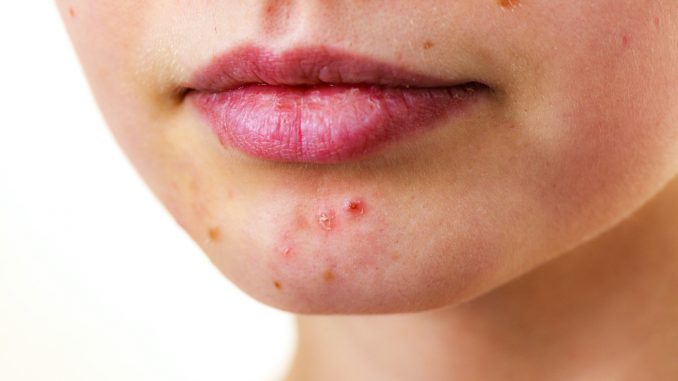
Almost 50 million people in the U.S. suffer from acne, and over one-third of the population suffers from obesity. When compared to other parts of the world, it seems the western diet is at fault. But what exactly links acne and obesity? And who even knew there was a connection? Here’s what dairy, junk food, and egg protein have to do with acne and obesity.
Acne and obesity in America
Acne affects between 40 to 50 million people in the US. Most sufferers are adolescents, although it’s also present in adults and children. One study found that 54 percent of women and 40 percent of men older than 25 suffered from facial acne. Acne, it seems, is a disease of epidemic proportions. However, compared to places like Okinawa in the South China Sea, where acne is almost non-existent, acne in America is prevalent in Western society.
Now, let’s talk about obesity. Forty percent of young adults, aged 20 to 39 years old, are obese in America, according to the Centers for Disease Control and Prevention (CDC). Almost 45 percent of middle-aged adults, aged 40 to 59 are also obese. And it doesn’t get better in your 60’s. Almost 43 percent of adults 60 and older are obese. These figures are staggering! Interestingly, there seems to be a correlation between acne and obesity.
The link between acne and obesity
Acne and obesity are modern-day diseases that may be linked to dairy, junk food, and egg protein in the Western diet. These foods, according to research, all work together to increase the activity of the enzyme “mTORC1” or “mTOR,” which regulates cell growth and metabolism. This enzyme has a major impact on cells including controlling growth, division, movement, and recycling of the cell, plus protein building, genetic messaging, and cell survival. An overproduction of mTOR leads to acne and obesity — and even cancer.
A little more about TOR
The enzyme mTOR, nicknamed the “engine of aging,” works as a master controller of cellular growth and production. While TOR is a necessity of life in early years, high levels of the enzyme in adulthood are bad for your body. Apart from an overproduction leading to acne and obesity, it’s also linked to a significantly higher risk of getting cancer and even dying prematurely. Research from UC Davis Integrative Medicine compares mTOR to a speeding car. When you’re young and growing, the car (mTOR) needs to go “fast.” Since, in infancy, your cells need to grow and multiply into early life.
But, when you enter adulthood, cell growth needs to slow. But if the enzyme mTOR is endlessly stimulated by foods like dairy, junk food, and egg proteins, it just can’t happen. The “engine of growth” in childhood turns into the “engine of aging” into adulthood. And you definitely don’t want to speed up aging. Research suggests that in almost 100 percent of advanced prostate cancer cases, mTOR is present in higher amounts. Likewise, when it comes to breast cancer. High levels of mTOR are found in breast cancer tissues and seem to be linked with advanced cancer and generally poorer survival rates.
Here’s what you can do…
To help prevent obesity and promote healthy acne-free skin, you need to suppress mTOR. By doing so, you not only help prevent obesity-related diseases and cancer, but you’ll also increase your chances of living longer. So, how do you suppress or tame the enzyme mTOR?
Limit animal protein
Good news for vegans. A good way to suppress mTOR production is to limit animal protein in your diet. It seems that the amino acid leucine, found in large amounts in animal proteins like dairy, eggs, meat, chicken, and fish, is the driver for mTOR. Your best bet is to adopt a 100 percent plant-based diet. But if that seems impossible, then limit your consumption. In fact, some of the best foods to help tame mTOR include arugula, collard greens, broccoli, bok choy, Brussel sprouts, cabbage, and cauliflower. Additionally, strawberries, blueberries, grapes, mangos, green tea, onion, soy, and turmeric also help decrease mTOR production.
Intermittent fasting
Another way to tame mTOR production is by severely restricting calories. Due to the over-abundance of junk food and animal products in the Western diet, mTOR is soaring. But when food is in shortage, mTOR shifts into preservation mode, thus slowing down cell division and kicking in a process called autophagy, which literally means to “eat oneself.” This process cleans and renews cells.
However, while this may not be the best option for many people, there is another way — intermittent fasting. Intermittent fasting is presently one of America’s most popular health trends. Studies show that by alternating cycles of fasting and eating, you can lose weight, help protect yourself from cancer, improve metabolic health, and even help you live longer. Restricting food intake has been found to prevent many age-related diseases and increase lifespan in rodents and many other species according to Research.
When you look at places like Okinawa, you can see how the “anti-western diet” works to keep elderly Japanese living strong and well, far into their later years. Acne and obesity barely exist in their culture, mainly because of their plant-based diet. In fact, only one percent of their diet, according to research, is made up of dairy, eggs, fish, and meat. Reducing foods so prevalent in the western diet, like dairy, junk food, and eggs may be our ticket to decreasing mTOR into adulthood. Decreasing the production of mTOR means healthier skin and trimmer waistlines. And trimmer waistlines may be your ticket to longevity.
Via Up Wellness
